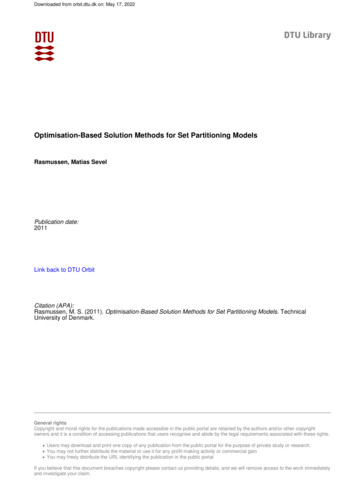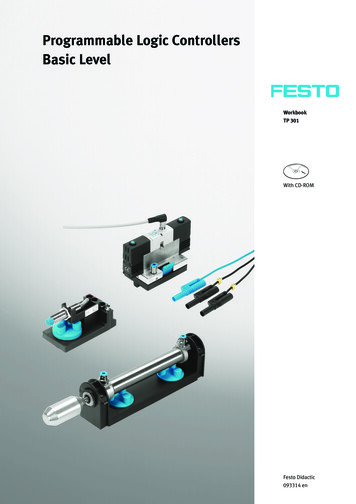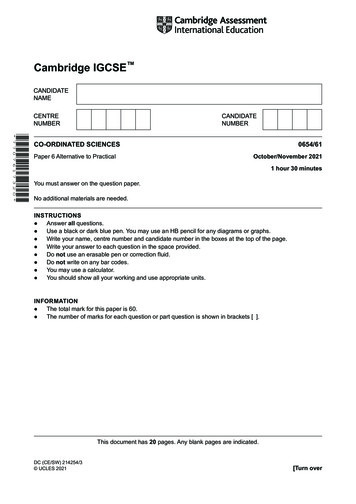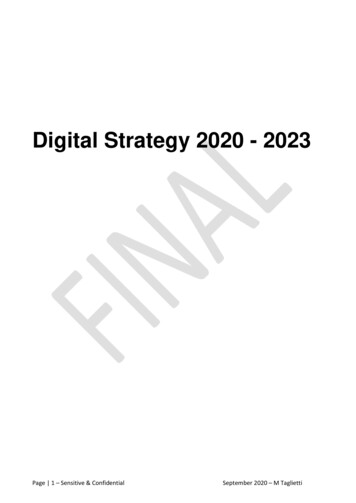
Transcription
Downloaded from orbit.dtu.dk on: May 17, 2022Optimisation-Based Solution Methods for Set Partitioning ModelsRasmussen, Matias SevelPublication date:2011Link back to DTU OrbitCitation (APA):Rasmussen, M. S. (2011). Optimisation-Based Solution Methods for Set Partitioning Models. TechnicalUniversity of Denmark.General rightsCopyright and moral rights for the publications made accessible in the public portal are retained by the authors and/or other copyrightowners and it is a condition of accessing publications that users recognise and abide by the legal requirements associated with these rights. Users may download and print one copy of any publication from the public portal for the purpose of private study or research. You may not further distribute the material or use it for any profit-making activity or commercial gain You may freely distribute the URL identifying the publication in the public portalIf you believe that this document breaches copyright please contact us providing details, and we will remove access to the work immediatelyand investigate your claim.
Optimisation-BasedSolution MethodsforSet Partitioning ModelsApplications in Crew SchedulingMatias Sevel RasmussenKgs. Lyngby, 2011
Matias Sevel RasmussenOptimisation-Based Solution Methods for Set Partitioning Models: Applications inCrew Scheduling(Optimeringsbaserede løsningsmetoder for set partitioning modeller: Anvendelser iarbejdsplanlægning)Ph.D. thesis, 2011ISBN [ISBN]Department of Management EngineeringTechnical University of DenmarkProduktionstorvet, Building 424DK-2800 Kgs. Lyngby, DenmarkPhone: 45 45 25 48 00, Fax: 45 45 25 48 05phd@man.dtu.dkwww.man.dtu.dkPrint: Vester Kopi, Virum, DenmarkCopyright c 2011
To Samantha
iv
SummaryThe scheduling of crew, i.e. the construction of work schedules for crew members, is often not a trivial task, but a complex puzzle. The task is complicatedby rules, restrictions, and preferences. Therefore, manual solutions as well as solutions from standard software packages are not always sufficient with respect tosolution quality and solution time. Enhancement of the overall solution qualityas well as the solution time can be of vital importance to many organisations.The fields of operations research and mathematical optimisation deal with mathematical modelling of difficult scheduling problems (among other topics). Thefields also deal with the development of sophisticated solution methods for thesemathematical models.This thesis describes the set partitioning model which has been widely used formodelling crew scheduling problems. Integer properties for the set partitioningmodel are shown, and exact and optimisation-based heuristic solution methodsfor the model are described. All these methods are centered around the wellknown column generation technique. Different practical applications of crewscheduling are presented, and some of these applications are considered in detailin four included scientific papers. It is shown how these applications all fit into ageneralisation of the set partitioning model. Each of the four papers contributea novel solution method for the specific application treated in the paper.
vi
Resumé (Danish summary)Arbejdsplanlægning for medarbejdere, dvs. udarbejdelse af arbejdsplaner formedarbejdere, er ikke altid en let opgave, men snarere et komplekst puslespil.Opgaven kompliceres af regler, restriktioner og præferencer. Manuelle løsninger,såvel som løsninger fundet ved hjælp af standard software, er derfor ikke altid tilstrækkelige med hensyn til løsningskvalitet og løsningstid. For mangeorganisationer kan forbedringer af løsningskvaliteten og løsningstiden være afafgørende betydning. Fagområderne operationsanalyse og matematisk optimering omhandler matematisk modellering af vanskelige planlægningsproblemer(blandt andre emner). Fagområderne omhandler også udvikling af sofistikeredeløsningsmetoder for disse matematiske modeller.Denne afhandling beskriver set partitioning modellen, som er blevet brugt ivid udstrækning til at modellere arbejdsplanlægningsproblemer. Heltalsegenskaber for set partitioning modellen vises, og eksakte samt optimeringsbaseredeheuristiske løsningsmetoder til modellen beskrives. Metoderne er alle centrerede omkring den velkendte søjlegenereringsmetode. Forskellige praktiske anvendelser inden for arbejdsplanlægning bliver præsenteret, og nogle af disse bliver behandlet i detaljer i fire inkluderede videnskabelige artikler. Det bliver visthvordan disse applikationer alle passer ind i en generaliseret udgave af set partitioning modellen. Hver af de fire artikler bidrager med en ny løsningsmetodefor den specifikke applikation som behandles i artiklen.
viii
PrefaceThis thesis has been submitted to the Department of Management Engineering,Technical University of Denmark in partial fulfilment of the requirements for acquiring the Ph.D. degree. The work has been supervised by Associate ProfessorJesper Larsen, Department of Management Engineering, Technical Universityof Denmark, and co-supervised by Professor David Ryan, Department of Engineering Science, The University of Auckland. David Ryan is also an AdjunctProfessor at Department of Management Engineering and Department of Transport, Technical University of Denmark.The thesis is made up of two parts. The first part forms an introduction to thetopics that have been investigated throughout the Ph.D. project. The secondpart is a compilation of four scientific papers that have been written during thePh.D. project. The Ph.D. project has been carried out from May 2008 to June2011.Kgs. Lyngby, June 2011Matias Sevel Rasmussen
x
Papers and Other WorkThe papers listed in the following have been produced during the Ph.D. project.The first list contains the most significant papers. These papers are also foundas appendices. The second list contains other papers such as technical reports,conference papers, and conference abstracts. The papers on the two lists haveoverlapping content, as they describe the same projects, though at differentstages of the projects. The last list shows theses that have been supervisedduring the Ph.D. project.
xiiPapers and Other WorkIncluded papers Paper A: M. S. Rasmussen, T. Justesen, A. Dohn, and J. Larsen (2011f).“The Home Care Crew Scheduling Problem: Preference-Based Visit Clustering and Temporal Dependencies”. European Journal of Operational Research. (Accepted for publication) Paper B: A. Dohn, M. S. Rasmussen, and J. Larsen (2011). “The Vehicle Routing Problem with Time Windows and Temporal Dependencies”.Networks. (Accepted for publication) Paper C: M. S. Rasmussen, R. M. Lusby, D. M. Ryan, and J. Larsen(2011d). “Subsequence Generation for the Airline Crew Pairing Problem”.Transportation Research Part E. (Submitted) Paper D: M. S. Rasmussen, R. M. Lusby, D. M. Ryan, and J. Larsen(2011b). “An IP Framework for the Crew Pairing Problem using Subsequence Generation”. Journal of the Operational Research Society. (Submitted)
xiiiOther papers, technical reports, and conferenceabstracts Journal paper: A. Dohn, M. S. Rasmussen, T. Justesen, and J. Larsen(2008a). “The Home Care Crew Scheduling Problem”. Orbit 13, pp. 19–23 Technical report: M. S. Rasmussen, T. Justesen, A. Dohn, and J. Larsen(2010c). The Home Care Crew Scheduling Problem: Preference-Based VisitClustering and Temporal Dependencies. Tech. rep. Department of Management Engineering, Technical University of Denmark Technical report: A. Dohn, M. S. Rasmussen, and J. Larsen (2009c).The Vehicle Routing Problem with Time Windows and Temporal Dependencies. Tech. rep. Department of Management Engineering, TechnicalUniversity of Denmark Technical report: M. S. Rasmussen, R. M. Lusby, D. M. Ryan, andJ. Larsen (2011e). Subsequence Generation for the Airline Crew PairingProblem. Tech. rep. Department of Management Engineering, TechnicalUniversity of Denmark Technical report: M. S. Rasmussen, R. M. Lusby, D. M. Ryan, andJ. Larsen (2011c). An IP Framework for the Crew Pairing Problem usingSubsequence Generation. Tech. rep. Department of Management Engineering, Technical University of Denmark Competition paper: M. S. Rasmussen, R. M. Lusby, D. M. Ryan, and J.Larsen (2011a). A Subsequence Generation Approach for the Airline CrewPairing Problem. AGIFORS Anna Valicek Award 2011. (Submitted) Conference paper: A. Dohn, M. S. Rasmussen, T. Justesen, and J.Larsen (2008b). “The Home Care Crew Scheduling Problem”. In: ICAOR’08 – Proceedings, 1st International Conference on Applied OperationalResearch. Ed. by K. Sheibani. Tadbir Institute for Operational Research,pp. 1–8 Conference paper: M. S. Rasmussen, D. M. Ryan, R. M. Lusby, and J.Larsen (2009a). “Solving the Airline Crew Pairing Problem using Subsequence Generation”. In: Proceedings of the 44th Annual conference of theOperational Research Society of New Zealand Conference paper: M. S. Rasmussen, D. M. Ryan, R. M. Lusby, andJ. Larsen (2010a). “Solving the Airline Crew Pairing Problem using Subsequence Generation”. In: Proceedings of the 8th International Conferenceon the Practice and Theory of Automated Timetabling (PATAT). Ed. byB. McCollum, E. Burke, and G. White
xivPapers and Other Work Conference paper: J. Larsen, A. Dohn, M. S. Rasmussen, and T. Justesen (2010). “The Home Care Crew Scheduling Problem”. In: Proceedingsof the 8th International Conference on the Practice and Theory of Automated Timetabling (PATAT). Ed. by B. McCollum, E. Burke, and G.White Conference abstract: M. S. Rasmussen, T. Justesen, A. Dohn, and J.Larsen (2009b). The Home Care Crew Scheduling Problem. 3rd NordicOptimization Symposium (NOS) Conference abstract: M. S. Rasmussen, A. Dohn, and J. Larsen (2009c).The Vehicle Routing Problem with Time Windows and Temporal Dependencies. International workshop in vehicle routing, intermodal transportand related areas (ROUTE2009) Conference abstract: M. S. Rasmussen, R. M. Lusby, D. M. Ryan,and J. Larsen (2010b). Solving the Airline Crew Pairing Problem usingSubsequence Generation. 4th Nordic Optimization Symposium (NOS)
xvProjects supervised Master’s thesis: P. D. Kostka (2009). “Planning of Air Crew Licenses”.Master’s thesis. Department of Management Engineering, Technical University of Denmark Master’s thesis: C. Schmidt (2009). “Solving the Crew Pairing Problemfor Cimber Air”. Master’s thesis. Department of Management Engineering,Technical University of Denmark Master’s thesis: J. Ahmt and J. S. Sigtenbjerggaard (2010). “A NewApproach to the Container Positioning Problem”. Master’s thesis. Department of Management Engineering, Technical University of Denmark Bachelor’s thesis: K. R. Poulsen (2009). “Optimering af flyoptankning[Optimisation of Aircraft Fueling]”. Bachelor’s thesis. Department of Management Engineering, Technical University of Denmark Bachelor’s thesis: N.-C. Pedersen (2011). “A Heuristic Approach to theShortest Path Problem with Resource Constraints”. Bachelor’s thesis. Department of Management Engineering, Technical University of Denmark
xvi
AcknowledgementsFirstly, I would like to thank my main supervisor, Associate Professor JesperLarsen, for support and guidance through the project period. With his broadknowledge Jesper has often suggested the right directions for my research, whenI was in doubt, and he has participated in an uncountable number of ad hocdiscussions which have moved me forward in research questions. Also, I thankhim for jokingly firing me only three or four times (despite numerous verbalwarnings), showing his very tolerant nature. Now that my time at DTU hascome to an end, I will miss being fired from time to time.During my one-year research stay in Auckland I had the chance to work withProfessor David Ryan. I thank David for letting me take part in his long andsuccessful campaign on promoting optimisation-based methods. His and RuthRyan’s hospitality is unparallelled, and I especially enjoyed the research discussions that were forced to take place on Waiheke Island and on Mount Ruapehu.Another Kiwi family to whom I owe great thanks is the Lusby family. Not onlydid they provide us with excellent wheels during our stay, we were also invitedto participate in an unforgettable Kiwi style Christmas with poolside barbecuebrunch and all other similar kinds of fantastic, relaxed traditions.Two persons fit into the noble category of friend-and-colleague: Tor Justesenand Richard Lusby. I am grateful for the good work and the good fun that wehave shared. In the future I hope that we will do a minimum of work and havea maximum of fun together.Tor and Richard plus Charlotte Vilhelmsen have kindly proofread and commented on this thesis for which I am deeply thankful. Also, I would like to
xviiiAcknowledgementsthank Anders Dohn for being a fantastic co-author, and of course everyone atOperations Research at DTU and at Engineering Science in Auckland (hereunder the German settlement in Western Springs) for providing a great workatmosphere. I thank DTU Management Engineering for the Ph.D. grant, and Ithank Tuborgfondet for supporting my stay in Auckland.Furthermore, I would like to thank my family and friends for support, dinners,and general good times. Especially, I thank my younger brother, Anders, forbeing as close to me (location-wise and figuratively speaking) as when he wasfour and had the very important position as fire dog in my fire brigade.Lastly, Samantha, my companion in life. Some time ago, I asked you to writethese lines in order to get them right. However, I have not received the textyet, and with the deadline approaching, I have to give it a try myself: Everymorning I wake up beside you, I feel fortunate. Truth be told, I dare not seemas unrealistically in love with you, as I am.
xix
xxContents
ContentsSummaryvResumé (Danish summary)viiPrefaceixPapers and Other WorkxiAcknowledgementsIxviiTheory and Applications11 Introduction1.1 Thesis organisation . . . . . . . . . . . . . . . . . . . . . . . . . .2 Set2.12.22.32.42.52.6Partitioning Extensions andSet packing . . . . . . . . . . .Set covering . . . . . . . . . . .Set partitioning . . . . . . . . .A unified model . . . . . . . . .The integer property . . . . . .Generalised set partitioning . .3 Solution Methods3.1 Column generation . . . . . .3.2 Finding integer solutions . . .3.3 Branch-and-price . . . . . . .3.4 Heuristic solution approaches.34Properties. . . . . . . . . . . . . . . . . . . . . . . . . . . . . . . . . . . . .567891117.2121262932.
xxiiCONTENTS4 Crew Scheduling Applications354.1 Scheduling of crew . . . . . . . . . . . . . . . . . . . . . . . . . . 354.2 Selected applications . . . . . . . . . . . . . . . . . . . . . . . . . 405 Overview of Papers475.1 Paper A: The Home Care Crew Scheduling Problem: PreferenceBased Visit Clustering and Temporal Dependencies . . . . . . . . 475.2 Paper B: The Vehicle Routing Problem with Time Windows andTemporal Dependencies . . . . . . . . . . . . . . . . . . . . . . . 505.3 Paper C: Subsequence Generation for the Airline Crew PairingProblem . . . . . . . . . . . . . . . . . . . . . . . . . . . . . . . . 515.4 Paper D: An IP Framework for the Crew Pairing Problem usingSubsequence Generation . . . . . . . . . . . . . . . . . . . . . . . 526 Additional Computational Experiments556.1 Comparison to current practice in home care . . . . . . . . . . . 556.2 Subsequence removal . . . . . . . . . . . . . . . . . . . . . . . . . 577 Conclusions637.1 Main contributions . . . . . . . . . . . . . . . . . . . . . . . . . . 647.2 Future research . . . . . . . . . . . . . . . . . . . . . . . . . . . . 65IIScientific Papers75A The Home Care Crew Scheduling Problem: Preference-BasedVisit Clustering and Temporal Dependencies77A.1 Introduction . . . . . . . . . . . . . . . . . . . . . . . . . . . . . . 79A.2 Problem formulation . . . . . . . . . . . . . . . . . . . . . . . . . 83A.3 Decomposition . . . . . . . . . . . . . . . . . . . . . . . . . . . . 87A.4 Branching . . . . . . . . . . . . . . . . . . . . . . . . . . . . . . . 90A.5 Clustering of visits and arc removal . . . . . . . . . . . . . . . . . 95A.6 Test instances . . . . . . . . . . . . . . . . . . . . . . . . . . . . . 97A.7 Computational results . . . . . . . . . . . . . . . . . . . . . . . . 98A.8 Conclusion and future work . . . . . . . . . . . . . . . . . . . . . 105B The Vehicle Routing Problemporal DependenciesB.1 Introduction . . . . . . . . . .B.2 Model . . . . . . . . . . . . .B.3 Decomposition . . . . . . . .B.4 Branching . . . . . . . . . . .B.5 Benchmark instances . . . . .B.6 Test results . . . . . . . . . .with Time Windows and Tem109. . . . . . . . . . . . . . . . . . . . 111. . . . . . . . . . . . . . . . . . . . 113. . . . . . . . . . . . . . . . . . . . 118. . . . . . . . . . . . . . . . . . . . 127. . . . . . . . . . . . . . . . . . . . 132. . . . . . . . . . . . . . . . . . . . 134
CONTENTSB.7 Conclusions and future workxxiii. . . . . . . . . . . . . . . . . . . . 140C Subsequence Generation for the Airline Crew Pairing Problem145C.1 Introduction . . . . . . . . . . . . . . . . . . . . . . . . . . . . . . 147C.2 Problem formulation . . . . . . . . . . . . . . . . . . . . . . . . . 149C.3 Subsequence limitation . . . . . . . . . . . . . . . . . . . . . . . . 151C.4 Subsequence generation . . . . . . . . . . . . . . . . . . . . . . . 153C.5 Computational results . . . . . . . . . . . . . . . . . . . . . . . . 157C.6 Conclusion and future work . . . . . . . . . . . . . . . . . . . . . 162D An IP Framework for the Crew Pairingquence GenerationD.1 Introduction . . . . . . . . . . . . . . . .D.2 Problem formulation . . . . . . . . . . .D.3 Subsequence methodology . . . . . . . .D.4 Integer programming framework . . . .D.5 Computational results . . . . . . . . . .D.6 Conclusion and future work . . . . . . .Problem using Subse167. . . . . . . . . . . . . . 168. . . . . . . . . . . . . . 171. . . . . . . . . . . . . . 173. . . . . . . . . . . . . . 178. . . . . . . . . . . . . . 181. . . . . . . . . . . . . . 186
xxivCONTENTS
Part ITheory and Applications
Chapter1IntroductionCrew scheduling problems arise in many areas, and sometimes the schedulingof crew is a trivial and uncomplicated task. However, for many crew schedulingproblems, there is a large number of rules, regulations, and restrictions thatmust be taken into account. These complicating factors originate from laws,union agreements, and local agreements (often only existing as tradition). Furthermore, individual preferences of the crew and the clients are important torespect as much as possible in order to maximise crew satisfaction. Withinthe fields of operations research and mathematical optimisation, crew scheduling problems are described mathematically. When finding solutions to specificproblem instances, it can indeed be very difficult to respect all complicatingfactors, while still maintaining a high solution quality, if a structured, mathematical, and computer-aided approach is not taken.In many areas of work, employees are both a scarce and an expensive resource.Therefore, good utilisation of crew is of vital importance to many organisations.The potential savings from using sophisticated decision support systems, thatcan deliver optimal or high quality solutions to crew scheduling problems, arelarge. One example is from Air New Zealand, where Butchers et al. (2001)report annual savings of NZD 15.7 million since the introduction of a new crewscheduling system. In addition, the schedules produced by the system, werebetter at respecting crew preferences. Another example is shown by Abbink etal. (2005). They describe how the major Dutch railway operator, Netherlands
4IntroductionRailways, have saved USD 4.8 million per year after the introduction of a crewscheduling system. These examples should motivate the need for continuedresearch within solution methods for crew scheduling problems.This thesis deals with modelling and finding solutions for selected practicalproblems arising in crew scheduling. Sometimes it is sufficient to model thegiven crew scheduling problem and then let a standard solver find solutions tothe problems. In many cases, however, this is not viable, simply because theproblem instances are too large, and therefore tailored solution methods mustbe crafted. The tailored solution methods fall in five categories: Heuristics,metaheuristics, approximation algorithms, exact methods, and optimisationbased methods. The focus of this thesis will be on the latter two.1.1Thesis organisationThe thesis is divided into two parts. Part I describes the problem setting plusrelevant theory and highlights the findings from the collection of papers presented in Part II.Part I is made up of six chapters in addition to this introductory chapter. Chapter 2 describes the well-known set packing, set covering, and set partitioningmodels. Integer properties for the models are discussed, and finally a generalcore model that captures the applications presented Part II. Chapter 3 coverssolution methods that have been widely used in the literature for solving problems based on the aforementioned models. The covered solution methods are afoundation for the solution methods presented in the papers of Part II. Chapter 4 introduces crew scheduling in general terms and a selection of importantcrew scheduling applications. Some of these applications have been investigatedin detail in the papers of Part II. In Chapter 5 we give brief introductions to thepapers of Part II. Additional computational experiments, that have not beendescribed in the papers, are reported in Chapter 6. Finally, in Chapter 7, wewill give a conclusion, highlight our contributions, and point out particularlyinteresting directions for future research.Part II is a collection of four scientific papers. These papers are the outcomes ofthe work done during the Ph.D. project. All of the papers have been submittedto international journals, and two of the papers have been accepted for publication at the time of writing. Changes are made to the layout of the papers inorder to give this thesis a uniform look, but the content is exactly the same asthe content submitted to the journals.
Chapter2Set Partitioning Extensionsand PropertiesWe begin this chapter with an introduction to three important and well-knownmodels: set packing, set covering, and set partitioning. The three models arerelated in the sense that they are concerned with finding an optimal family ofsubsets of elements from a set, and they are used as the basis for the applicationsin this thesis. A comprehensive survey on especially the theory of the set packing, set covering, and set partitioning models can be found in Balas and Padberg(1976), and in Vemuganti (1998) a survey with emphasis on applications of themodels can be found.We state a model that unifies the three problems. We present four classes ofmatrices that can appear as input to the problems. All four classes have theproperty, that one can automatically solve the problem by solving a relaxed andcomputationally easier version of the problem. At last we extend the unifiedmodel to also cover additional types of constraints.
62.1Set Partitioning Extensions and PropertiesSet packingThe first model we will present is the set packing problem in which a pairwisedisjoint family of subsets from a given set must be found, such that the addedprofit of the subsets is maximised. The set packing problem is well-studied inthe literature and has been used to model many practical applications. Forinstance: Rönnqvist (1995) develops a set packing model for a cutting stockproblem and solves it with Lagrangian relaxation combined with subgradientoptimisation. Lusby et al. (2009) give a survey of models and methods forrailway track allocation, including formulations that rely on the set packingmodel. Avella et al. (2006) model the Intelligent Tourist Problem (schedulingof a tourist’s visits with maximum satisfaction) with a set packing model andsolve it with a linear programming based heuristic. Rossi and Smriglio (2001)model the Ground Holding Problem from airports and solve it with a branchand-cut algorithm.The set packing problem is formally defined below.Definition 2.1 [Set packing problem] Let S {1, . . . , m} be a set of m elements, and let {S1 , . . . , Sn } be a family of n subsets of S, that is, Sj S forall j {1, . . . , n}. A packing Q {Sj1 , . . . , Sjk } is a subfamily of {S1 , . . . , Sn },where the elements in Q are pairwise disjoint, i.e. Sjs Sjt for alls, t {1, . . . , k} with s 6 t. Let cj be the profit associated with subset Sjfor all j {1, . . . , n}. The set packing problem is then to find a packing withmaximum profit.The set packing problem with unit profits is N P-hard (Garey and Johnson,1979; Crescenzi and Kann, 1997), and therefore the more general set packingproblem defined above is also N P-hard. It should be noted that there alwaysexists at least one feasible solution, namely Q .Let A be an m n zero-one matrix with entries aij for all i {1, . . . , m} andj {1, . . . , n} defined by 1 if i Sjaij ,(2.1)0 otherwiseand let xj for all j {1, . . . , n} be a binary decision variable defined by 1 if Sj Qxj ,0 otherwise(2.2)and let c be the vector of profits cj for all j {1, . . . , n}. Now we can write the
2.2 Set covering7set packing problem as the following binary integer programme:maximisec x(2.3)subject toAx 1(2.4)x {0, 1}n .(2.5) The jth column Aj (a1j , . . . , amj ) of the A matrix is the column representation of the subset Sj . Constraints (2.4) enforce that the subsets are pairwisedisjoint.2.2Set coveringA problem related to the set packing problem is the set covering problem. In thisproblem a minimum cost family of subsets from a given set, where the subsetscover the whole set, must be found. The literature has many practical applications of set covering models. Huisman (2007) models rail crew re-scheduling witha set covering model and devises a column generation-based solution algorithm.In some periods of time, rail tracks are out of service due to maintenance, andthis affects the timetable, the rolling stock schedules and hence also the crewschedules. The crew re-scheduling is due to planned maintenance and not a recovery due to an unforeseen disruption. Real-world instances from NetherlandsRailways are used for testing. Rubin (1973) uses a set covering formulation tosolve the airline crew pairing problem.The set covering problem is formally defined below.Definition 2.2 [Set covering problem] Let S {1, . . . , m} be a set of m elements, and let {S1 , . . . , Sn } be a family of n subsets of S, that is, Sj S for allj {1, . . . , n}. A cover Q {Sj1 , . . . , Sjk } is a subfamily of {S1 , . . . , Sn }, whereSkQ covers all elements of S, that is s 1 Sjs S. Let cj be the cost associatedwith subset Sj for all j {1, . . . , n}. The set covering problem is then to find acover with minimum cost.The set covering problem with unit costs is N P-hard (Garey and Johnson, 1979;Crescenzi and Kann, 1997), and therefore the more general setSncovering problemdefined above is also N P-hard. It should be noted that, if j 1 Sj S, therealways exists at least one feasible solution, namely Q {S1 , . . . , Sn }.Let again A be an m n zero-one matrix with entries aij for all i {1, . . . , m}and j {1, . . . , n} defined by Equation (2.1), and let xj for all j {1, . . . , n}be a binary decision variable defined by Equation (2.2). Let c be the vector of
8Set Partitioning Extensions and Propertiescosts cj for all j {1, . . . , n}. The set covering problem can now be written asthe following binary integer programme:minimisesubject toc xAx 1(2.6)(2.7)x {0, 1}n .(2.8) Still, the jth column Aj (a1j , . . . , amj ) of the A matrix is the columnrepresentation of the subset Sj . Constraints (2.7) enforce that the subsets coverall elements of S.2.3Set partitioningThe basic version of the core problem in this thesis can now be presented: Theset partitioning problem. In this problem a minimum cost family of pairwisedisjoint subsets from a given set, where the subsets cover the whole set, must befound. A lot of attention has been given to the set partitioning problem in theliterature. Balinski and Quandt (1964) formulate a truck delivery problem as aset partitioning model and solve the model by a cutting plane algorithm wherethe columns are generated a priori. Garfinkel and Nemhauser (1969) introducethe set partitioning problem as a set covering problem with equality constraintsand give a solution algorithm. Desaulniers et al. (1997) use a set partitioningmodel solved with column generation to do crew scheduling for Air France. InRezanova and Ryan (2010) a recovery problem for train driver duties is modelledby a set partitioning model and solved in a column generation-based framework.Brønmo et al. (2010) use a set partitioning model and column generation to solvea short-term ship scheduling problem where the cargo sizes are flexible. Cargoeshave a given profit rate, and some cargoes must be carried out while others canbe negotiated on the spot market. A schedule, i.e. a sequence of ports, for eachship must be build, and the objective is to maximise profit.The set partitioning problem is formally defined below.Definition 2.3 [Set partitioning problem] Let S {1, . . . , m} be a set of melements, and let {S1 , . . . , Sn } be a family of n subsets of S, that is, Sj Sfor all j {1, . . . , n}. A partitioning Q {Sj1 , . . . , Sjk } is a subfamily of{S1 , . . . , Sn }, where the elements in Q are pairwise disjoint, i.e. Sjs Sjt for all s, t {1, . . . , k} with s 6 t, and also Q covers all eleme
Larsen (2009a). \Solving the Airline Crew Pairing Problem using Subse-quence Generation". In: Proceedings of the 44th Annual conference of the Operational Research Society of New Zealand Conference paper: M. S. Rasmussen, D. M. Ryan, R. M. Lusby, and J. Larsen (2010a). \Solving the Airline










